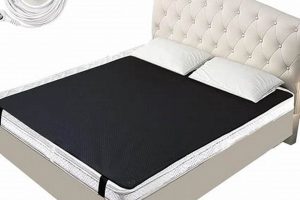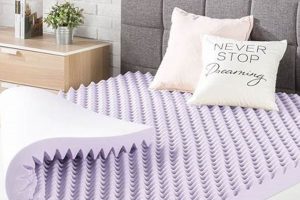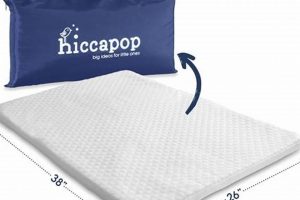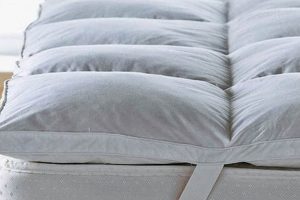These encasements are specifically designed to create a barrier between a mattress and bed bugs. They function as protective covers, fully enclosing the mattress and preventing bed bugs from infesting it or escaping from within. For example, a zippered, tightly woven fabric encasement around a mattress serves this purpose.
Using these protective covers offers several advantages. They help control existing infestations by trapping bed bugs already inside the mattress, eventually leading to their demise. Furthermore, they prevent new infestations by blocking bed bugs from reaching the mattress, a prime hiding and breeding location. Historically, such protective measures were basic but have evolved into sophisticated, laboratory-tested products now readily available, reflecting an increasing awareness of effective bed bug management.
The following sections will delve into the selection criteria for these protective covers, outlining key features and materials to consider. Additionally, maintenance guidelines will be provided to ensure long-term efficacy and prolong the lifespan of the encasement, maximizing the investment in effective bed bug prevention.
Selecting and Utilizing Protective Mattress Encasements
The following are recommendations to ensure effective selection and use of mattress encasements for bed bug management.
Tip 1: Prioritize Quality Material: Select encasements constructed from tightly woven fabrics with small pore sizes. This feature prevents bed bugs from penetrating the material. Example: Fabrics with a pore size of less than 10 microns are generally considered effective.
Tip 2: Ensure Secure Zippers: Inspect the zipper closure for durability and a tight seal. The zipper should completely close, leaving no gaps. Many high-quality encasements include a velcro flap to further secure the zipper end.
Tip 3: Verify Bed Bug Proof Certification: Look for certifications from independent testing laboratories. These certifications ensure that the encasement has been tested and proven to be bed bug proof.
Tip 4: Thoroughly Inspect Existing Mattresses: Before encasing a mattress, conduct a detailed inspection for any signs of bed bugs. If an infestation is present, consider professional treatment before applying the encasement to avoid trapping the pests inside.
Tip 5: Regularly Inspect the Encasement: Routinely check the encasement for rips, tears, or compromised seams. Address any damage promptly to maintain its protective barrier. Immediate repair or replacement is crucial.
Tip 6: Follow Washing Instructions: Adhere to the manufacturer’s washing instructions. Regular cleaning helps maintain hygiene and ensures the long-term effectiveness of the encasement.
Tip 7: Encase Both Mattress and Box Spring: For comprehensive protection, encase both the mattress and the box spring. Bed bugs can inhabit both surfaces, so protecting both is vital to eliminate potential hiding places.
Effective mattress encasements are a crucial element in bed bug prevention and control. By selecting quality products and implementing diligent maintenance practices, one can significantly minimize the risk of infestation and protect sleeping environments.
The subsequent sections will address alternative bed bug control strategies and explore the integration of encasements within a broader integrated pest management approach.
1. Tight Fabric Weave
The efficacy of bed bug mattress encasements is intrinsically linked to the tightness of their fabric weave. This characteristic dictates the encasement’s ability to act as a barrier, preventing bed bugs from infesting or escaping a mattress. A fabric with a loose weave provides opportunities for bed bugs to penetrate, rendering the encasement ineffective.
- Pore Size as a Critical Factor
The term “tight weave” refers directly to the size of the pores within the fabric. A smaller pore size restricts the passage of bed bugs, nymphs, and their eggs. For example, fabrics tested with a pore size of less than 10 microns are generally considered bed bug proof. Pore size is essential because bed bugs, particularly newly hatched nymphs, are exceptionally small and can exploit even minor openings.
- Material Composition and Weaving Technique
The material from which the encasement is made and the weaving technique employed play a significant role in achieving a tight weave. Certain synthetic materials, such as polyester or microfiber, lend themselves to tighter weaving patterns than natural fibers. Similarly, specialized weaving techniques, like interlocked or high-density weaves, create a more compact fabric structure. These factors directly influence the encasement’s ability to resist bed bug penetration.
- Durability and Longevity Implications
While tightness of weave is paramount, it should not compromise the fabric’s durability and longevity. An overly tight weave may result in a stiff or easily torn material, reducing the encasement’s lifespan. Therefore, a balance must be struck between weave tightness and overall fabric resilience. Reinforced seams and durable zippers further contribute to the product’s longevity and effectiveness.
- Certification and Testing Standards
Independent laboratory testing and certification provide assurance of a product’s actual performance regarding weave tightness. Reputable certifications verify that the encasement has undergone rigorous testing to confirm its ability to prevent bed bug passage. Consumers should prioritize products bearing these certifications to ensure they are purchasing an effective solution.
In summary, the tight fabric weave is a critical determinant of a protective encasement’s effectiveness against bed bugs. Selecting an encasement with a confirmed small pore size, durable materials, and recognized certifications is crucial for effective prevention and control of infestations. These considerations maximize the protection afforded to mattresses and box springs.
2. Secure Zipper Closure
The secure zipper closure is a critical component of any effective bed bug mattress encasement. Its function is to completely seal the mattress within the encasement, preventing both the entry and exit of bed bugs. A compromised zipper renders the entire encasement ineffective, regardless of the quality of the surrounding fabric. Consider the example of an encasement made of tightly woven material; if the zipper has gaps or is easily opened, bed bugs can readily bypass the primary barrier, negating the encasement’s intended purpose. Thus, the secure zipper closure functions as the lynchpin of an effective bed bug mattress encasement system.
Various factors contribute to a zipper’s security in this context. The tightness of the zipper teeth interl
ock is paramount; gaps between teeth allow bed bugs, especially nymphs, to squeeze through. Some encasements utilize zippers with micro-teeth or double-layered teeth to minimize this risk. Additionally, the presence of a fabric flap covering the zipper adds an extra layer of protection, further preventing bed bugs from reaching or escaping through the zipper. Durability of the zipper is also key; a flimsy zipper that breaks easily compromises the encasement over time. Heavy-duty zippers made of metal or durable plastic offer increased reliability.
In conclusion, the secure zipper closure represents a critical, non-negotiable element in bed bug mattress encasement design. Its presence and proper function are essential for creating an effective barrier against bed bug infestations. The failure of this component undermines the value of the entire encasement. Therefore, careful attention must be paid to zipper quality and design when selecting a bed bug mattress encasement. Prioritizing secure zipper closures ensures the encasement performs its intended function: preventing bed bug infestations and protecting the mattress.
3. Certifications
Certifications serve as independent verification of a “bed bug mattress pad’s” performance claims, providing consumers with objective evidence of its effectiveness. They are vital in a market where claims may not always align with actual product capabilities.
- Independent Testing Laboratories
Organizations such as entomological testing facilities subject mattress encasements to rigorous evaluation protocols. These protocols simulate real-world conditions to determine if bed bugs can penetrate or escape the encasement. Certification from such a lab signifies the encasement has met predetermined performance standards.
- Standards and Protocols
Specific testing protocols, often developed by industry associations or government agencies, define the methodology for assessing “bed bug mattress pad” performance. These protocols dictate the number of bed bugs used in the test, the duration of the exposure, and the criteria for determining passage. Adherence to a recognized standard lends credibility to the certification.
- Claim Verification
Certifications substantiate manufacturers’ claims regarding bed bug resistance. Terms such as “bed bug proof,” “bed bug resistant,” or “allergen barrier” have specific implications, and certifications provide consumers with confidence that these claims have been validated by a third party. They provide a safety net against unsubstantiated marketing language.
- Long-Term Performance
While some certifications focus on initial resistance, others assess long-term performance, considering factors such as washability, durability, and continued effectiveness after repeated use. Certifications that address long-term performance offer a more comprehensive assurance of product quality and value.
The presence of a recognized certification mark on a “bed bug mattress pad” provides assurance that the product has been subjected to independent testing and meets defined performance criteria. These certifications are valuable resources for consumers seeking effective solutions for bed bug prevention and control, mitigating the risks associated with unverified claims and substandard products.
4. Mattress Inspection
Prior to the implementation of any bed bug mitigation strategy involving protective encasements, rigorous mattress inspection is paramount. This assessment determines the existing state of infestation, which directly influences the subsequent application and effectiveness of a “bed bug mattress pad.”
- Identification of Infestation
Visual inspection aims to identify indicators of bed bug presence, including live insects, cast skins, fecal stains, and blood spots. The intensity and location of these signs inform the extent of the infestation, guiding decisions regarding mattress treatment prior to encasement. Failure to identify an existing infestation prior to encasement can trap the bed bugs inside, exacerbating the problem.
- Assessment of Mattress Condition
The condition of the mattress itself dictates the suitability for encasement. Tears, rips, or compromised seams provide harborage points for bed bugs and weaken the protective barrier. A severely damaged mattress may require replacement rather than encasement to ensure effective bed bug control. Identifying pre-existing damage helps to make informed decisions regarding remediation efforts.
- Determination of Treatment Needs
Depending on the findings of the inspection, pre-encasement treatment might be necessary. This could involve vacuuming, steam cleaning, or professional insecticide application. The goal is to reduce the bed bug population within the mattress before sealing it inside the encasement. Thorough inspection helps to determine the appropriate treatment approach to maximize the encasement’s efficacy.
- Validation of Encasement Need
In some cases, the inspection may reveal no evidence of bed bugs. While prophylactic encasement can provide a preventative barrier, it might not be necessary. The inspection helps determine whether the investment in a “bed bug mattress pad” is warranted or whether other preventative measures are sufficient. It justifies resource allocation based on actual risk rather than perceived threat.
Mattress inspection serves as the cornerstone of an effective bed bug control strategy involving encasements. It provides essential information for determining the appropriate course of action, ensuring that the “bed bug mattress pad” is implemented effectively and efficiently. Neglecting this crucial step can lead to ineffective control and continued infestation.
5. Regular Inspection
Regular inspection is integral to maintaining the efficacy of a “bed bug mattress pad” as a bed bug control measure. The function of the encasement hinges on its structural integrity; breaches in the barrier, however small, compromise its protective capability. Therefore, scheduled examinations of the encasement for damage are crucial. For instance, a routine check might reveal a tear caused by accidental contact with a sharp object. Without this discovery and subsequent repair, the encasement ceases to perform its intended purpose, potentially allowing bed bugs to infest or escape the mattress.
Inspections should not be limited to the surface of the encasement. Particular attention must be paid to the zipper area, seams, and corners, as these areas are prone to wear and tear. Furthermore, the inspection process should consider the surrounding environment. The presence of bed bug signs near the bed frame or headboard, even if the encasement appears intact, may indicate a larger infestation that requires additional control measures. This broader assessment ensures that the encasement is functioning as part of a comprehensive bed bug management plan.
In conclusion, the value of a “bed bug mattress pad” is contingent on the implementation of a schedule of regular inspections. These inspection
s identify potential weaknesses in the protective barrier, allowing for timely repairs or replacements. This proactive approach maximizes the lifespan and effectiveness of the encasement, contributing to long-term bed bug prevention and control. Ignoring this critical step significantly diminishes the investment in the encasement and increases the risk of bed bug proliferation.
6. Proper Encasement
Proper encasement is not simply the act of placing a “bed bug mattress pad” on a mattress, but rather a multifaceted process critical to the efficacy of the protective covering. This process necessitates adherence to specific techniques and criteria to ensure the encasement fulfills its intended function as a barrier against bed bugs.
- Correct Sizing and Fit
An encasement must precisely match the dimensions of the mattress to avoid gaps or excessive slack. Undersized encasements are impossible to install correctly, while oversized encasements create folds that can harbor bed bugs. Manufacturers provide sizing charts to ensure accurate selection based on mattress dimensions. A proper fit guarantees complete coverage and a taut, secure barrier.
- Appropriate Installation Techniques
Encasement installation must follow specific procedures to avoid damaging the material or compromising the seal. This often involves carefully slipping the encasement over the mattress, ensuring all corners are correctly aligned, and slowly zipping the encasement closed. Rushing the process or forcing the encasement can result in tears or zipper malfunctions, rendering it ineffective.
- Zipper Sealing Protocols
The zipper represents a potential weak point in the encasement’s defense. After zipping the encasement completely closed, it is often necessary to secure the zipper pull with a Velcro flap or other closure mechanism. This prevents accidental opening or subtle gaps that bed bugs could exploit. Many high-quality encasements incorporate zipper-locking features to further enhance security.
- Associated Bed Frame Considerations
While the “bed bug mattress pad” protects the mattress, the bed frame itself can provide harborage for bed bugs. Proper encasement should be considered in conjunction with treatment or preventative measures applied to the bed frame. This may involve applying insecticides to the frame, using interceptor traps on the legs, or regularly inspecting and cleaning the frame to eliminate potential hiding places. A holistic approach to bed bug management is critical for success.
In summation, proper encasement extends beyond the selection of a “bed bug mattress pad,” encompassing careful sizing, meticulous installation, secure zipper sealing, and consideration of the surrounding bed frame. These interconnected elements are essential for establishing and maintaining an effective barrier against bed bug infestations. Neglecting any of these aspects diminishes the overall effectiveness of the protective encasement strategy.
Frequently Asked Questions
This section addresses common inquiries regarding bed bug mattress encasements, providing clarity on their function, selection, and usage.
Question 1: Are all mattress encasements effective against bed bugs?
No. The effectiveness of a mattress encasement depends on its construction and materials. Encasements must be specifically designed and tested to prevent bed bugs from penetrating the fabric and zipper.
Question 2: How does a bed bug mattress pad protect against infestations?
A properly designed and installed encasement creates a physical barrier, preventing bed bugs from infesting the mattress. It also traps any existing bed bugs inside, eventually leading to their demise. This dual action helps control and prevent infestations.
Question 3: What features should be considered when selecting a bed bug mattress pad?
Key features include a tightly woven fabric with a pore size small enough to prevent bed bug penetration (typically less than 10 microns), a secure zipper closure with a locking mechanism or flap, and certification from an independent testing laboratory.
Question 4: Can a bed bug mattress pad eliminate an existing bed bug infestation?
While an encasement can help control an existing infestation by trapping bed bugs inside the mattress, it is not a standalone solution. Comprehensive bed bug control typically requires additional measures, such as professional pest control services.
Question 5: How often should a bed bug mattress pad be inspected and cleaned?
Regular inspection is crucial to ensure the encasement remains intact. Inspect the encasement monthly for tears, rips, or zipper malfunctions. Cleaning should follow the manufacturer’s instructions, typically involving washing with mild detergent and drying on low heat.
Question 6: Is it necessary to encase both the mattress and the box spring?
Yes. Bed bugs can infest both the mattress and the box spring. To achieve comprehensive protection, both surfaces should be encased with appropriate bed bug-proof encasements.
In summary, bed bug mattress encasements are valuable tools for bed bug prevention and control, but their effectiveness depends on proper selection, installation, and maintenance. They are best utilized as part of a broader integrated pest management strategy.
The next section will explore alternative bed bug control methods and their integration with the use of mattress encasements.
Conclusion
This exploration has elucidated the multifaceted nature of “bed bug mattress pad,” underscoring its critical role in bed bug management. The assessment covered essential aspects, ranging from material selection and proper installation to the necessity of regular inspection and complementary strategies. The emphasis throughout has been on rigorous adherence to established protocols and informed decision-making.
Effective bed bug control demands vigilance and a comprehensive approach. Implementing the principles outlined herein significantly mitigates the risk of infestation and safeguards sleeping environments. Consistent monitoring and proactive measures are essential to maintain long-term protection and prevent the resurgence of these persistent pests. Further research and development will undoubtedly refine existing strategies and yield new, more effective solutions in the ongoing battle against bed bugs.







![Best California King Pillow Top Mattress Pad [Comfort+] Organic & Natural Mattress Buyer’s Guide: Non-Toxic Sleep Solutions Best California King Pillow Top Mattress Pad [Comfort+] | Organic & Natural Mattress Buyer’s Guide: Non-Toxic Sleep Solutions](https://mattressworldpa.com/wp-content/uploads/2025/07/th-4703-300x200.jpg)